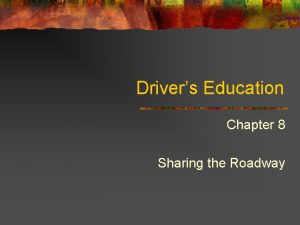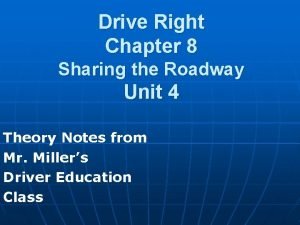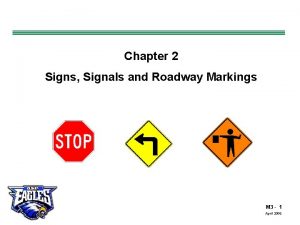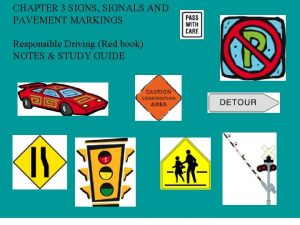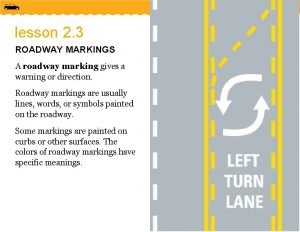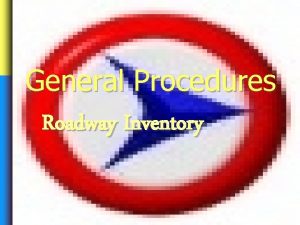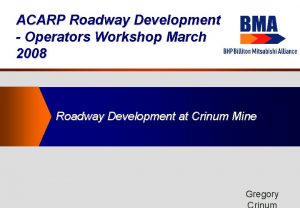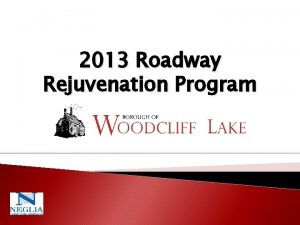Chapter 13 Sharing the Roadway Lesson One Sharing






- Slides: 6

Chapter 13 Sharing the Roadway

Lesson One Sharing the Roadway with Pedestrians and Animals What Problems do Pedestrians Pose to Drivers? Children • smaller, less visible, less likely of judging when it’s safe to cross the street Adults • will jaywalk and assume drivers will see them and stop for them How Can You Avoid Collisions with Pedestrians? • SIPTE What Responsibilities Do Pedestrians Have? • Never assume a driver will see you • Cross only at intersections • Wait for green light and “walk” symbol • Don’t step off the curb while waiting for the light to change • Pause before crossing and listen and check for traffic • Walk facing traffic • When walking or jogging along the road wear reflective clothing and don’t wear headphones • Hold children’s hand when crossing the street

How Can Drivers Avoid Collisions with Animals? Small Animals • Violent evasive action is not advisable Large Animals • Collision can be fatal to animal and driver Using SIPDE to Avoid Collisions with Animals • Be especially cautious when driving through farmland or wooded areas • When possible allow room to maneuver • Be cautious and vigilant at night and dusk • Watch for warning signs • Drive past animals slowly (cows, horses, dogs, etc. …) • Striking at animal may be the less serious collision

Lesson Two Sharing the Roadway with Motorcycles and Bicycles How Can You Recognize and Reduce the Risk of Problems Caused by Cyclists? Watching Out for Cyclists • Motorcycles and bicycles are easily hidden from drivers Dangerous Roadway Conditions • Cyclists make major adjustments when – at storm drains, gravel surfaces, and potholes – on rain-slicked roads or through large puddles – getting caught in unexpected rain or snow – being blown by wind Lack of Protection • bikes and motorcycles do not have the protection of the shell of a car • be cautious in neighborhoods when bikes and motorcycles may enter from driveways and side streets Failure to Obey Traffic Laws • Motorcycles often break the traffic rules Irresponsible Drivers • Be considerate to motorcycles and bicycles What Special Responsibilities Do Motorcyclists Have? • They have the same responsibilities as other drivers

Lesson Three Sharing the Roadway with Other Vehicles How Can You Safely Share the Roadway with Other Vehicles? Trucks and Tractor-Trailers • Visibility – Large trucks larger blind spots • Time – allow more time when passing and following trucks • Space - allow more space when passing and following trucks • Allow at least a 4 second following distance Buses • Stop frequently to release and pick up passengers • Watch out for passengers • You are required to stop for school busses • Allow at least a 4 second following distance Small Cars • Often have less power and may be slower going uphill • When driving a small car allow extra space and time when passing • More likely to skid or be blown by wind Other Kinds of Vehicles • Emergency vehicles – yield right of way to emergency vehicles • Snowmobiles – often hard to see. Allow extra time and space to adjust for unexpected maneuvers. • Sport utility vehicles – taller and has better view of traffic ahead but when following on you view may be obstructed • Ice-Cream trucks – in some states drivers must stop when they have flashing lights. • Maintenance vehicles – be alert for them and adjust accordingly How Do You Deal with Slow-Moving Vehicles? • Consider what they may do before passing as tractors may turn off suddenly • Of vehicle is a wide load vehicle then reduce speed and follow at a safe distance

Lesson Four Safe Driving Procedures at Railroad Crossings How Can You Drive Through a Railroad Crossing Safely? Determine When It Is Safe to Cross • Slow down when crossing and determine if it safe to cross • Don’t cross if warning lights are flashing • Check both directions after train has passed (may be double tracks) • Wait for the vehicle ahead to cross before proceeding Stay Alert • Drivers who travel the same route every day need to remain vigilant Do Not Panic If Your Vehicle Stalls • Try to restart • If you can’t restart and no trains are coming try to push the vehicle off • If train is coming then get well away and behind point of contact
